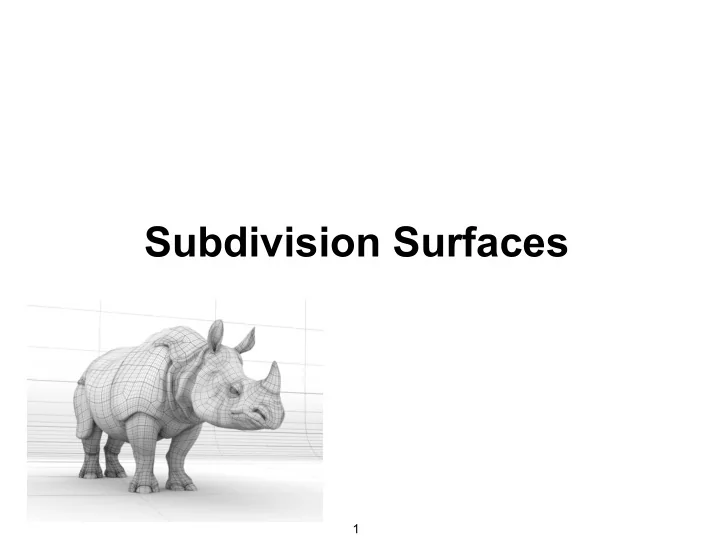

Subdivision Surfaces 1
Geometric Modeling • Sometimes need more than polygon meshes – Smooth surfaces • Traditional geometric modeling used NURBS – Non uniform rational B-Spline 2
Problems with NURBS • A single NURBS patch is either a topological disk, a tube or a torus • Must use many NURBS patches to model complex geometry • When deforming a surface made of NURBS patches, cracks arise at the seams 3
Subdivision “Subdivision defines a smooth curve or surface as the limit of a sequence of successive ” refinements 4
Subdivision
Subdivision Surfaces • Generalization of spline curves / surfaces – Arbitrary control meshes – Successive refinement (subdivision) – Converges to smooth limit surface – Connection between splines and meshes 6
Subdivision Surfaces • Generalization of spline curves / surfaces – Arbitrary control meshes – Successive refinement (subdivision) – Converges to smooth limit surface – Connection between splines and meshes 7
Example: Geri’s Game (Pixar 1997) • Subdivision used for – Geri’s hands and head – Clothing – Tie and shoes 8
Example: Geri’s Game (Pixar) Woody’s hand (NURBS) Geri’s hand (subdivision) 9
Example: Geri’s Game (Pixar) • Sharp and semi-sharp features 10
Subdivision Curves Given a control polygon... ...find a smooth curve related to that polygon. 12
Subdivision Curve Types • Approximating • Interpolating 13
Approximating 14
Approximating Splitting step: split each edge in two 15
Approximating Averaging step: relocate each (original) vertex according to some (simple) rule... 16
Approximating Start over ... 17
Approximating ...splitting... 18
Approximating ...averaging... 19
Approximating ...and so on... 20
Approximating If the rule is designed carefully ... ... the control polygons will converge to a smooth limit curve! 21
Equivalent to … • Insert single new point at mid-edge • Filter entire set of points. 22
Corner Cutting • Subdivision rule: – Insert two new vertices at ¼ and ¾ of each edge – Remove the old vertices – Connect the new vertices – In the limit, generates a curve called a quadratic B-Spline 23
B-Spline Curves • Piecewise polynomial of degree n B-spline curve control points parameter value basis functions 24
Cubic B-Spline even odd 27
Cubic B-Spline odd even 28
Cubic B-Spline odd even 29
Cubic B-Spline odd even 30
Cubic B-Spline odd even 31
Cubic B-Spline odd even 32
Cubic B-Spline odd even 33
Cubic B-Spline odd even 34
Cubic B-Spline odd even 35
Cubic B-Spline odd even 36
Cubic B-Spline odd even 37
Cubic B-Spline odd even 38
Cubic B-Spline odd even 39
Cubic B-Spline odd even 40
B-Spline Curves • Distinguish between odd and even points • Linear B-spline – Odd coefficients (1/2, 1/2) – Even coefficient (1) 25
B-Spline Curves • Quadratic B-Spline (Chaikin) – Odd coefficients ( ¼ , ¾ ) – Even coefficients ( ¾ , ¼ ) • Cubic B-Spline (Catmull-Clark) – Odd coefficients (4/8, 4/8) – Even coefficients (1/8, 6/8, 1/8) 26
B-Spline Curves • Subdivision rules for control polygon • Mask of size n yields C n -1 curve 41
Interpolating (4-point Scheme) • Keep old vertices • Generate new vertices by fitting cubic curve to old vertices • C 1 continuous limit curve 42
Interpolating 43
Interpolating 44
Interpolating 45
Interpolating 46
Interpolating 47
Subdivision Surfaces • No regular structure as for curves – Arbitrary number of edge-neighbors – Different subdivision rules for each valence 48
Subdivision Rules • How the connectivity changes • How the geometry changes – Old points – New points
Subdivision Zoo • Classification of subdivision schemes Primal Faces are split into sub-faces Dual Vertices are split into multiple vertices Approximating Control points are not interpolated Interpolating Control points are interpolated 50
Subdivision Zoo • Classification of subdivision schemes 51
Subdivision Zoo • Classification of subdivision schemes 52
Catmull-Clark Subdivision • Generalization of bi-cubic B-Splines • Primal, approximation subdivision scheme • Applied to polygonal meshes • Generates G 2 continuous limit surfaces: – C 1 for the set of finite extraordinary points • Vertices with valence ≠ 4 – C 2 continuous everywhere else 53
Catmull Clark Subdivision NOTE: valence = number of neighboring vertices First subdivision generates quad mesh Some vertices extraordinary (valence ≠ 4) Rules Face vertex = average of face’s vertices Edge vertex = average of edge’s two vertices & adjacent face ’ s two vertices New vertex position = (1/valence) x sum of… • Average of neighboring face points • 2 x average of neighboring edge points • (valence – 3) x original vertex position Boundary edge points set to edge midpoints Boundary vertices stay put
Catmull-Clark Subdivision 55
Catmull-Clark Subdivision
Catmull-Clark Subdivision
Catmull-Clark Subdivision
Face ¡vertex ¡= ¡average ¡of ¡face ’ s ¡ver/ces ¡ Edge ¡vertex ¡= ¡average ¡of ¡edge ’ s ¡two ¡ver/ces ¡ Implementation ¡& ¡adjacent ¡face ’ s ¡two ¡ver/ces ¡ New ¡vertex ¡posi/on ¡= ¡(1/valence) ¡x ¡sum ¡of… ¡ Average ¡of ¡neighboring ¡face ¡points ¡ 2 ¡x ¡average ¡of ¡neighboring ¡edge ¡points ¡ Face vertex (valence ¡– ¡3) ¡x ¡original ¡vertex ¡posi/on ¡ For each face add vertex at its centroid v x 1 y 1 z 1 Edge vertex v x 2 y 2 z 2 v x 3 y 3 z 3 How do we find each edge? v x 4 y 4 z 4 New vertex position … For a given vertex f 1 2 3 4 how do we find neighboring ... faces and edges?
Comparison 69
Comparison • Subdividing a cube – Loop result is assymetric, because cube was triangulated first – Both Loop and Catmull-Clark are better then Butterfly ( C 2 vs. C 1 ) – Interpolation vs. smoothness 70
Comparison • Subdividing a tetrahedron – Same insights – Severe shrinking for approximating schemes 71
So Who Wins? • Loop and Catmull-Clark best when interpolation is not required • Loop best for triangular meshes • Catmull-Clark best for quad meshes – Don’t triangulate and then use Catmull-Clark 72
Recommend
More recommend